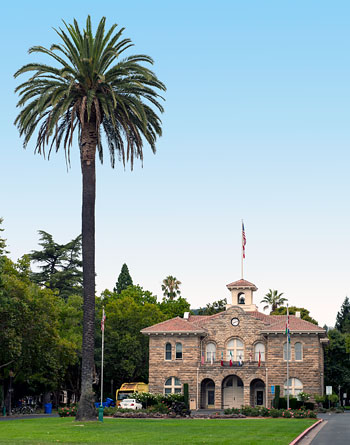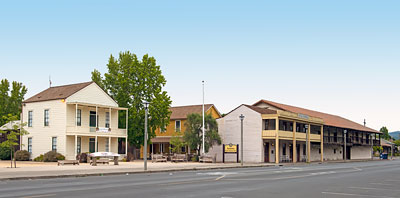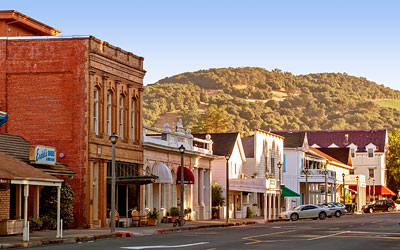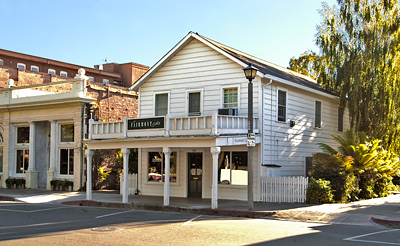National Register of Historic Places in Sonoma County, California
Sonoma Plaza
Center of Sonoma
Sonoma
Built in 1835 By Mexico
Sonoma Pueblo was the chief military base of the Mexican Government in Alta California.
In 1823, Misión San Francisco Solano de Sonoma was founded. It was the the last (northernmost) of the twenty-one Alta California missions and the only one established under Mexico rule.
In 1835, General Mariano Vallejo laid out the plaza as a parade ground for Mexican soldiers stationed at Sonoma Presidio. It is the largest central plaza in California.
On June 14, 1846, the raising of the Bear Flag in the Plaza marked the beginning of the American revolt against Mexican rule.

Sonoma Plaza has been a National Historic Landmark (NHL) since 1960 when the National Historic Landmark program was established. 92 properties were immediately designated as National Historic Landmarks including seven in California. Sonoma Plaza was the northernmost California landmark.
The district was listed on the National Register of Historic Places in 1975. The NRHP district is slightly larger than the NHL district.
All seven California landmarks were built during the rule of Spain or Mexico:
- El Presidio Real de San Diego
- Santa Barbara Mission
- Carmel Mission
- Royal Presidio Chapel (Monterey)
- Old Custom House (Monterey)
- Thomas Larkin House (Monterey)
- Sonoma Plaza
When the National Register of Historic Places was established in 1966, the National Historic Landmark program was encompassed within it.

The boundaries of the NRHP district were expanded in 1992 to include properties on Broadway and the north side of East Napa Street.
| Name | Year | Address | Remarks | Sort Address | Sort Name |
|---|---|---|---|---|---|
| Baptist Church | 1850 | First Street East | Street 01 E | Baptist Church | |
| Batto Building | 1909 | 453 First Street West | Street 01 W 0453 | Batto Building | |
| Masonic Hall | 1909 | 465 First Street West | Street 01 W 0465 | Masonic Hall | |
| Bear Flat Flag Staff and Monument | 1913 | Plaza, Northeast Corner | Plaza 05 | Bear Flat Flag Staff and Monument | |
| Blue Wing Inn | 1849 | 133 East Spain Street | Spain E 0133 | Blue Wing Inn | |
| Casa Grande Site and Servants Quarters | 1840 | West Spain Street | Spain W | Casa Grande Site and Servants Quarters | |
| Castagnasso House | 1850 | 256 East Spain Street | Spain E 0256 | Castagnasso House | |
| Clewe Residence | 1880 | 531 Second Street East | Street 02 E 0561 | Clewe Residence | |
| Country Inn | 1896 | 110 West Spain Street | Spain W 0110 | Country Inn | |
| Duhring Residence | 1860 | 532 Second Street East | Street 02 E 0562 | Duhring Residence | |
| El Dorado Hotel | 1840 | 411-17 First Street West | Street 01 W 0411 | El Dorado Hotel | |
| Italianate Commercial Building | Napa Street | Napa | Italianate Commercial Building | ||
| Jones Adobe | 143 West Spain Street | Spain W 0143 | Jones Adobe | ||
| Leese-Fitch Adobe | 1841 | 487 First Street West | Street 01 W 0487 | Leese-Fitch Adobe | |
| Duhring Building | 1892 | 498 First Street East | Street 01 E 0498 | Duhring Building | |
| Mission San Francisco Solano de Sonoma | 1823 | 114 East Spain Street | Spain E 0114 | Mission San Francisco Solano de Sonoma | |
| Nash - Patton Adobe | 1847 | 579 First Street East | Street 01 E 0579 | Nash - Patton Adobe | |
| Poppe House | 1850 | 564 First Street East | Street 01 E 0564 | Poppe House | |
| Ray-Adler Adobe | 1848 | 114 East Spain Street | Spain E 0114 | Ray-Adler Adobe | |
| Ruggles Building | 1870 | 433 First Street West | Street 01 W 0433 | Ruggles Building | |
| Sonoma Antique Shop | 1850 | 447 First Street West | Street 01 W 0447 | Sonoma Antique Shop | |
| Sonoma Barracks | 1836 | West Spain Street and First Street East | Spain W | Sonoma Barracks | |
| Sonoma City Hall | 1906 | Number 1, The Plaza | Plaza 01 | Sonoma City Hall | |
| Swiss Hotel | 1843 | 18 West Spain Street | Spain W 0018 | Swiss Hotel | |
| Taylor House | 1852 | 114 East Spain Street | Spain E 0114 | Taylor House | |
| Toscano Hotel | 1857 | 20 Spain Street | Spain 0020 | Toscano Hotel | |
| Salvador Vallejo Adobe | 1843 | 421 First Street West | Street 01 W 0421 | Salvador Vallejo Adobe | |
| Vasquez House | 1851 | 541 First Street West | Street 01 W 0541 | Vasquez House |
This wood-frame structure has a Classic Revival design characteristic of the early 1850s. When it was listed on the National Register, it housed an antique shop.



